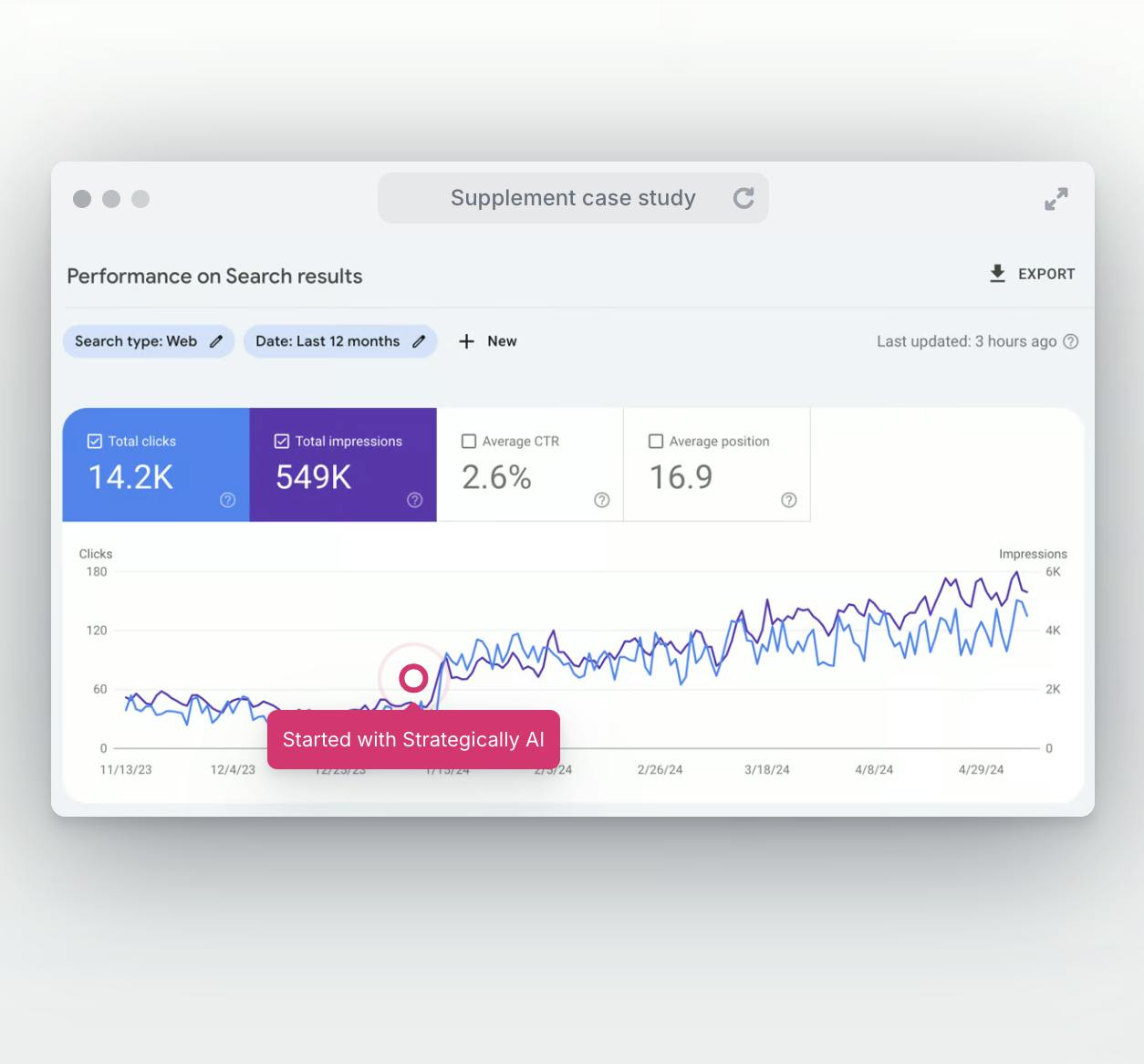I’m going to show you how we built 22 (and counting!) high-quality backlinks from one piece of content — in less than 10 days.
(Without paying a dime to link farms.)
The top secret?
Data-driven content.
In this article, I will show you exactly how I did it, step by step.
Step 1: Choose your topic
The first step is to decide what topic to write about, obvs. As obvious as that may be, the topic selection can make or break your link-building success.
Your topic should be determined by your data-driven content strategy. If you don’t have a content strategy, make sure that your topic meets these core criteria:
- Is the topic relevant to your business and goals?
- Does it answer a question an ideal customer might have during their buying journey?
- Do people search for this topic?
- Is it realistic, and will you be able to rank for the keyword(s)?
- Will relevant websites link to the topic?
Here’s how we met the criteria:
As an SEO content writing agency, we understand the importance of blogging, but we also know that content alone isn’t the silver bullet.
If you want people to visit your site organically, you need content. But to help your content rank and attract potential customers, you need amongst other things a “good” domain authority.
We offer link-building and SEO services; therefore, domain authority is directly related to our business goals. But we also wanted to ensure we answered a common question asked by our clients; we needed to address and offer some real value to something that was a real pain point for them.
Our customers often ask, “how can I increase my domain authority?” We felt confident that this topic met the first two criteria well.
Next, we wanted to see how the numbers stacked up. So we headed over to Ahrefs to uncover the metrics. Did people search for the topic and could we rank for it?
Starting with “domain authority increase”, we could see a traffic potential of 450, with a keyword difficulty of 45. When we opened up our analysis to related keywords, we increased the traffic potential to 950, just for a handful of the related terms.

So, do people search for the term? Yes, they do. Criteria met? Well, almost.
This answer depends on your SEO preferences and goals. Some people opt for super high-volume search terms, while other espouse the value of targeting even zero volume keywords. It’s up to you.
Depending on which side of the fence you’re on, you may be screaming at your computer saying that the search volume (950) is too low. We disagree (please don’t hate us), as we see total value in going after lower volume keywords. It’s how we get a ton of high-intent leads through the site, so we’re happy with this metric.
But what about keyword difficulty (KD)? This is a bit, well a lot, tougher than we’d like, given our relatively low current domain authority. Hovering around 28, we know we’ve still got plenty of work to improve on this front.
With a KD of 45, we’re definitely punching over our weight on this one, but we pulled up our big girl pants and decided to give it a shot. Remember, the aim is to build a highly authoritative piece of content with original research, which will generate backlinks. We’re okay with a competitive landscape on this occasion.
Finally, we can see that the top pages ranking for the keywords all have significant numbers of backlinks, so we’re happy that this final criterion is satisfied too.

Of course, these metrics are personal, and you’ll have your guidelines for what works and doesn’t work for your business. There’s no right or wrong, and your red lines will likely change over time.
Step 2: Determine your unique angle
Now, here comes the fun. Head over to Google and enter your topic and keywords. Read through the articles that are on the top page for your keyword(s).
How are they answering the question? Can it be answered in a different or better way? Is there a data-driven answer?
Here are the top dogs for our topic:

Eeek, we’re up against some helluva tough competition. But before we throw in the towel, here’s the good news:
None of the current articles answers the question with data.
In fact, nearly all offer a fairly standard list of steps to increase domain authority. That’s great, they are awesome articles written by undisputed SEO legends, but there’s definitely room for a different answer here.
But, in the words of Brian Dean, we really needed to pull some 10X content out of the proverbial bag.
We knew we wanted to tell our customers “how to increase their domain authority”, and this information would also be valuable to potential customers.
But how could we answer this question in a unique way?
Well, hello, data!
Instead of listing some generic steps to increase domain authority like many other blogs, we wanted to answer the question using factual data from real-life businesses that had achieved this goal in a short period of time.
By showing the data and real-world results, we can build a picture of what businesses did to increase their DA within a certain timeframe and extrapolate how you can do this for your business.
Pretty neat, huh?
Armed with the topic and unique angle, our data geeks got to work to uncover what businesses that had successfully increased their domain rating had done to achieve the results.
They analysed the data to answer questions like:
- Do the companies with higher DA have more backlinks?
- How many more backlinks?
- What was the domain rating of the backlinks?
- How quickly did they increase their Domain Rating?
- How quickly did they get their backlinks?
- What were the SEO results of the businesses with the higher DAs?
…. and so on.
We found the data points to answer the questions above for a sample of high-growth SaaS companies and built up a picture of what had worked for them. I won’t drill down into the details, but you can read the full data-driven study into increasing your domain authority here.
Step 3: Write the article
The next step is to write, edit, and optimise the article. We’re an SEO writing company, meaning we always take SEO into account.
This article really needs to shine. Not only does it need to offer extreme value to your readers, but it also needs to include 100% original research and be pixel-perfect in terms of writing, data, imagery, and so on.
Phew. The pressure’s on!
To make sure your article is beautiful, well-structured, and pleases the google bots, consider the heading hierarchy, the overall flow and the blog layout. However, arguably most important is to ensure that you’re answering your reader’s question. Nothing goes down like a damp squib more than reading an in-depth article only to be left with your initial question unanswered.
Finally, once you’re happy with the content, it’s time to optimise the page. We’re not ashamed to say we wax lyrical about Surfer SEO. We use it religiously with our content and attribute our number one positions to it:

Cue obligatory happy dance here:

Step 4: Find relevant blogs to reach out to
Now you have your epic article, it’s time find a list of relevant blogs to reach out to. Using a tool like Ahrefs, go through the keywords your article is targeting one by one, for example:
- how to increase domain authority
- domain authority increase
- increase domain authority
- how to increase your domain authority
- best way to increase domain authority
Then select “top pages”. You will be presented with a list of the web pages currently ranking for each keyword. You can export this list as possible sites to reach out to, but you can go a step further.

Select the down arrow next to each URL and view the pages backlinks. This creates a list of websites linked to the top blogs ranking for your keywords.

Rinse and repeat this process until your eyes bleed. Just kidding (kind of).
You can keep adding to and expanding this list infinitim, and it’s entirely possible that you’ll end up down a rabbit hole, but the more relevant blogs you can reach out to, the better.
Next, use a tool like Apollo.io or good ‘ol fashioned elbow grease to hunt down contact details for the websites.
Give yourself a pat on the back; you’re now the proud owner of a huge google sheet with a list of relevant blogs and their contact details. Just what you always wanted.
Step 5: Create your outreach cadence
To get backlinks to the blog, you need to tell people about it. And, despite the fact it’s 2022, one of the best way to do this is (still) via email.
But…if you’re a business owner or even just a person with an inbox, you know the annoyance of receiving emails begging, erm, asking for a favour. So we recommend taking your time on this step, to find a unique way to pique the web owners’ interest.
Arguably, creating a perfectly unique and original answer to a highly relevant question is enough. But, since we’ve gone to such effort to create a 10X blog, why not take the time to do the same with your emails?
We created a three-step email designed to tickle its readers and brighten their inboxes with a little humour.
Here’s how we charmed our way into their inbox:

Then we dropped our value bomb:

And here’s how we signed off:

In a similar jovial vein, we sent two follow-up emails aiming to convert everyone on our list to a backlink.
Guess what? It worked.
We sent out 150 emails and got 22 high-quality backlinks, aka a sweet 15% conversion rate. About a third of all the backlinks are DA 50 +, while two-thirds are DA 30 or over.
Not bad. And we’re only getting started.

It’s early days. We’ve only been promoting the blog for around ten days, and there’s a ton of untapped potential. We’re excited to see where it takes us. We’ll post updates here as we progress.
And that’s a wrap
And there you have it!
That’s how we generated 22+ high-quality backlinks from just one piece of content without paying link farms or resorting to spammy techniques.
Are you going to give it a try? What question relating to your business could you answer in a unique way? How can you add value to your readers?
Time to put pen to paper. Sayonara, friends.








